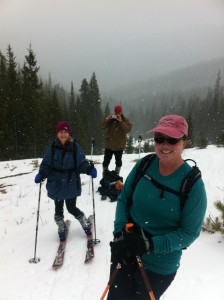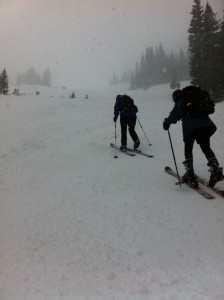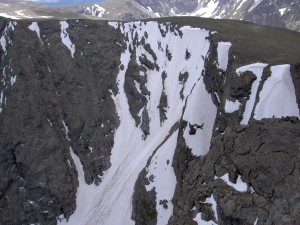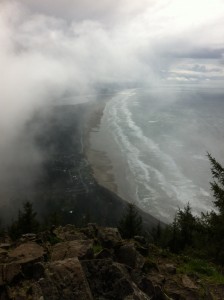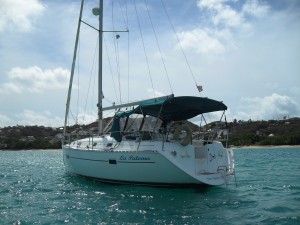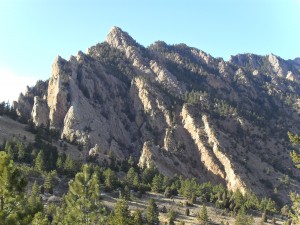The Militant Environmentalist
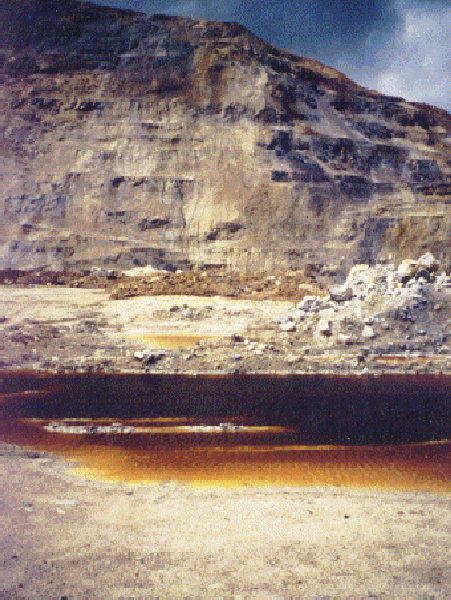 Contaminated water at the abandoned Summitville Mine in the San Juan Mountains of Colorado
Contaminated water at the abandoned Summitville Mine in the San Juan Mountains of Colorado
What would you do to prevent an environmental disaster such as what happened at the Summitville Mine in the early 1990s? I told the true story in Forty Demons of how a private Canadian company, seeking profit from industrial-scale gold mining, destroyed vast areas of Colorado wilderness, poisoned streams and forced the state and federal government to spend hundreds of millions of dollars in a clean-up attempt.
Do we, as a society, need to tolerate this kind of irresponsible action simply because a company wants to extract an unusable mineral? Yes, gold is “valuable” but mainly as bullion. It sits inertly in a vault somewhere forever. Yet the wilderness that was brutally destroyed to extract this metal cannot be re-created. It may be rehabilitated to a degree, but it will never be completely restored. Anyone who has ever driven through the mountains of Colorado can see the scars and tailing piles left by mines that were dug more than 100 years ago. Just like today, once the “money” is gone, the mines are abandoned and nothing gets cleaned up.
When Winston saw the possibility of this same thing happening in the Uncompahgre Wilderness, not far from the Summitville disaster site, he took drastic action. To him, the wilderness was a holy land and these developments were an intolerable outrage. He was compelled to take action. Something drastic.
Posted in 40 Demons Archive by Mark with comments disabled.
Journal
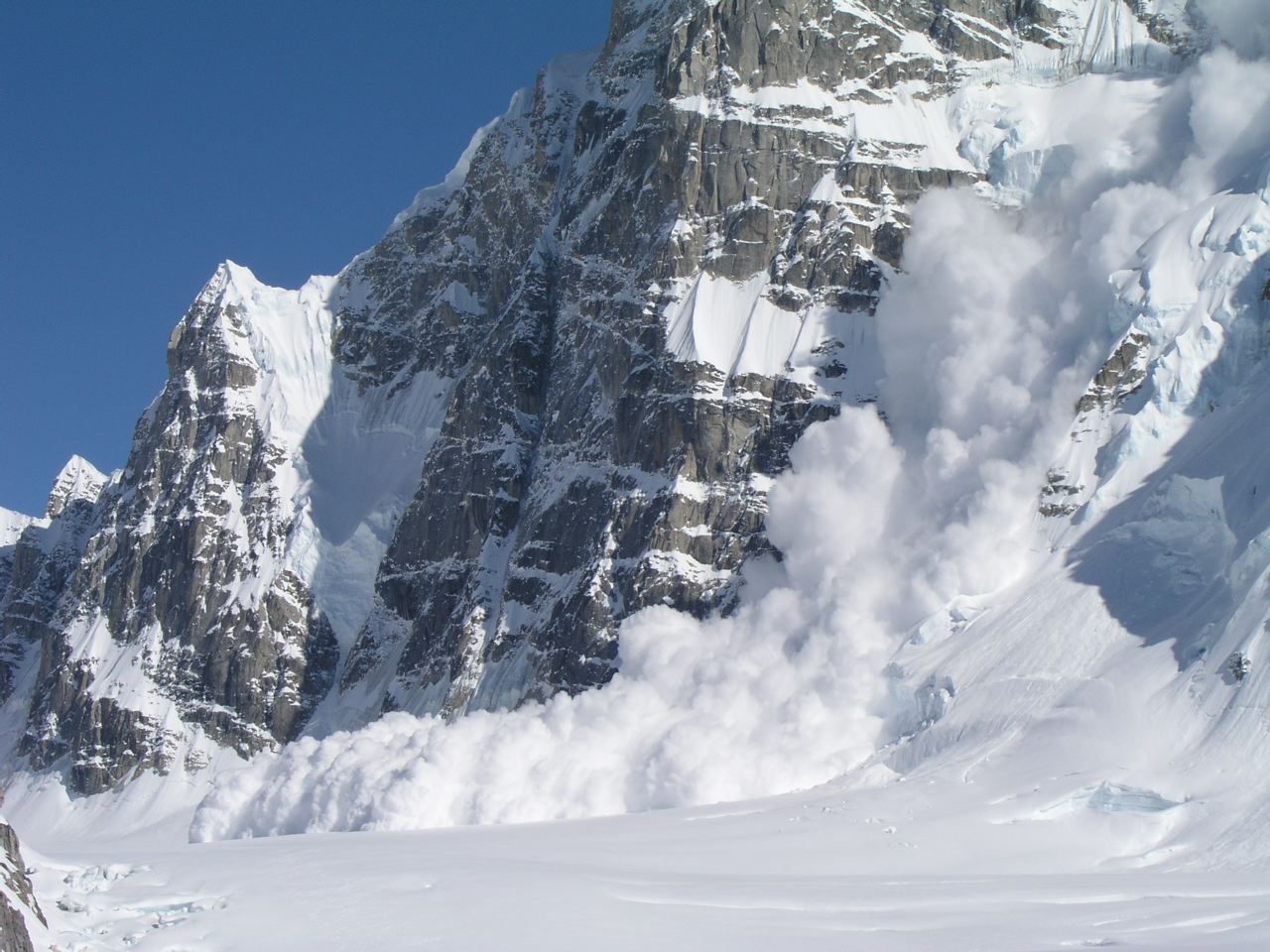
An Avalanche
Here is some of my bold yet exciting commentary about recent news items:
Avalanches: An avalanche survival story caught my attention recently. Alex White and Joe Philpott were backcountry skiing near Cameron Pass when they were caught and buried by an avalanche. Both were buried and Philpott did not survive. White, on the other hand, survived for over three hours before he was dug out by rescuers. This is nothing short of amazing. Avalanche victims are killed by either the trauma of the washing machine effect of an avalanche, or buy suffocation after burial or both.
While snow is flowing during an avalanche, it is like a powerful river flowing over boulders, cliffs and through trees, an irresistible force that carries victims like flotsam. When the flow stops, the snow “sets up like cement.” During the flow stage, the snow particles are almost in a state of liquid water that flows yet the overall temperature is below freezing. Once that snow stops, it’s like a pool of water that instantly freezes, solidifying more tightly than it had been prior to the avalanche. And like a frozen pool of water, almost all the air pockets in the snow are filled in. If your head is under the snow level when the snow stops, you are likely stuck in a solid tomb. Many victims are found with their mouths and noses filled with snow.
This isn’t always the case, though, which gives hope to victims and rescuers alike that survival is possible and searchers should continue until they find the victim. Surprisingly, there have been more than a few recent survival stories after long-term burial. Other strange things have happened in avalanches over the years, I wrote about one at Yankee Doodle lake, possibly the strangest avalanche in Colorado history, in Playing for Real.
By the way, the pic above is an avalanche on Mount Hunter in Alaska. On two of my trips there I witnessed big avalanches coming down this same chute, so large that the snow plume ran completely across the valley and covering our tent, a mile away, in a layer of snow dust. A spectacular force of nature.
Solo Survival: Never underestimate the power of the wilderness to make you suffer for your mistakes, or the strength of will to survive, or the consistency of human nature to produce endless stories of how these two interact. This story about Mary Owen who recently survived a week-long ordeal on Mount Hood in Oregon is one of the latest. Unlike the avalanche survival story above which was nothing short of amazing, this one is nothing short of predictable.
The inevitable story line is as follows:
- A plan is made to accomplish something.
- Events lead the plan astray.
- A chain of mistakes and bad decisions are made.
- Intense determination and single-mindedness blind the victim to all warning signs that things are going wrong.
- An accident happens.
- Great human suffering follows.
Then, either
A. The victim survives with at great story to tell, or
B. The victim dies.
This is the story told in The Endurance, Touching the Void, 127 Hours, etc. The great willpower that enables a victim to survive injury and starvation is the same willpower that blinded them to their mistakes in the first place. Of course, because this kind of story is captivating, I tell similar tales in Colorado 14er Disasters, where I try to put focus on the chain of mistakes being made. A great number of mountaineering disasters are not the result of a single bad event but rather a series of smaller events that add up to badness.
To me, the most interesting aspect of Mary Owen’s story is how she interprets her view of God in relation to her ordeal. It was understandably a life-changing event to her as it would be to anyone; to be injured, lost, and alone with the threat of death very near and then to be saved. But I don’t see anything miraculous. I don’t mean to single her out but the unfortunate thing for anyone caught in a mountain accident is that their story usually becomes public knowledge. This isn’t necessarily a bad thing and I am certain she will learn from her mistakes and maybe others will as well. She really did nothing that all dedicated climbers do at some point in their lives, and the good part is that she lived to tell her story. Which is…
…A strong-willed young climber determined to summit decides to solo a difficult mountain at a dangerous time of year. Ignoring or ignorant of easily available information about necessary and prudent equipment, she goes up alone without properly informing anyone about her plans. She gets lost in bad weather, not unusual for a person of this type of attitude. She is injured, which is not unusual for someone who is tired in difficult terrain, and survives several days in harsh conditions, which is difficult but again not unusual. She is missed at some point and a search team is dispatched to find her. And they find her.
Not a single aspect of her ordeal was unexpected.
Posted in Journal by Mark with comments disabled.
Hidden Valley Ski
Half Way Up. Left to Right, Melinda, Clint, Shelly.
Last weekend we drove up to Rocky Mountain National Park and did some backcountry skiing in Hidden Valley with our friends Melinda and Clint. This is an old ski area that closed in 1992 and was rehabilitated several years ago, meaning the Park Service demolished the old lifts and ski structures in the area to make it look more natural. I wrote about the re-opening of the area in my Insolent Guide. It turns out that you can read the chapter online here, courtesy of Google Books illegally ripping of my material and publishing it online. Thanks a lot, Google!
 Anyway, the excursion started out in warm temps under partly cloudy skies, and the snow conditions looked terrible. And the conditions were terrible, at first that is. Slushy and crusty. But this is spring and these were spring conditions, though it was more like May than March.
Anyway, the excursion started out in warm temps under partly cloudy skies, and the snow conditions looked terrible. And the conditions were terrible, at first that is. Slushy and crusty. But this is spring and these were spring conditions, though it was more like May than March.
Once we got going things improved a bit and winter returned. The base of Hidden Valley is at 9,500 feet and the old ski runs climb up to 11,500 feet to a ridge line above treeline. As we climbed up, snow squalls rolled over the ridge and would briefly engulf us in a blizzard before giving way to more sunshine. The squalls increased in length until we reached Trail Ridge road.
The road is closed in winter, as are most roads in Colorado that rise above treeline. It is expensive to keep these roads open, they would require snow plowing at least twice a day whether it snows or not, due to the fact that 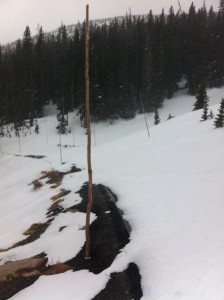 the wind blows constantly at this altitude, drifting over the unprotected roads. Trail Ridge road runs for many miles above treeline and the snow can build sometimes well over ten feet deep over the season.
the wind blows constantly at this altitude, drifting over the unprotected roads. Trail Ridge road runs for many miles above treeline and the snow can build sometimes well over ten feet deep over the season.
This year has been a low snow year as can be seen in the pictures. Trail Ridge road can be seen on the left. Notice the tall poles marking the edges of the roadway. These are used to guide the plows when the they open the road in the late spring, usually around Memorial Day. The poles are probably 12 feet tall so that they are visible in deep snow, but so far this year they’re unnecessary, the snow is so thin you can see the road pavement and the ground.
We got lucky and experienced a full-on blizzard just above the road crossing, which was about our high point. As you can see in the photo below, the snow was driving down hard, at least for a few minutes. The wind died down but the snow kept falling while we removed the skins from our skis and turned for an excellent downhill run. The snow conditions had improved because of the inch or so of new accumulation, but wow, the mountains could really use about 10 feet of new stuff. Not likely this year I guess.
Posted in Trip Reports by Mark with 1 comment.
Journal
Taylor Glacier in Rocky Mountain National Park. Ski-able from the top!
I have to comment on this article about the “new” sport of uphill skiing. It’s a long article but in a nutshell it describes a growing trend of people who want access to groomed ski resort slopes and rather than ride the lift up, they climb under their own power and ski down.
How is this done? You buy specialized ski equipment called alpine touring gear, or AT gear. With normal downhill ski gear, your boots are securely locked flat onto your skis. With AT boots and bindings, you can release your heel while your toe remains attached. The hinge at the toe allows you to walk. You can then attach skins to the underside of your skis, a long sticky strip that grips your ski bottom on one side, and a felt side that has low forward friction and very high reverse friction, thus you can hike uphill and not slide backward.
We have been doing this for decades under the moniker ski mountaineering. However, mountaineering can be intimidating to many and so a new, safer activity was invented using the same techniques called uphill skiing. Uphill skiers want to avoid the inherent dangers of mountains. They want to avoid avalanches and the kind of spectacular accidents I wrote about in this article. But they do want to get outside for a fantastic workout that is not possible with downhill skiing.
The solution is to visit ski resorts where the environment is controlled and presumably safer, but not always, as this recent avalanche in Arapahoe Basin ski area proves. The skiers can attach skins to their skis, hike up the groomed ski slope to the top, remove the skins and get a great downhill run. They can’t get in as many downhill runs as the downhill skier, but the uphill skier gets the benefit of an aerobic workout.
This is exactly what ski mountaineers have been doing ever since skis were invented. But now we have a new, tamer version practiced in a resort. And this is the future, according to the companies that sell the equipment. Places like Steamboat saw the benefit and allow this activity on their slopes. Eldora, just above Boulder, does not.
Why is that? Eldora claims it is a safety/liability issue. Perhaps so, but liability hasn’t stopped many of the much larger resorts like Steamboat from allowing it.
I think the safety/liability excuse is disingenuous and the actual reason is because they won’t be able to charge for their expensive lift tickets. Eldora, being close to the super-fit, outdoor crazy Boulder population is likely to see much larger numbers of uphill’ers than other resorts.
I can all but guarantee that Eldora will allow uphill skiing at some point because they won’t be able to stop the poachers. What they should do, like other resorts, come up with a use fee, something like what they charge for the Nordic center. The only question is how much money they want to lose in the meantime.
———————————————————-
It’s ironic that Boulder, one of the major centers of the outdoor recreation universe, severely restricts activities that other areas encourage. The lack of uphill skiing in Eldora is one example. Ice climbing is another. I wrote about the impediments to ice climbing in Boulder Canyon several years ago, and nothing has changed since then except that the sport has grown much larger and many of those ice climbers live in Boulder. Ice climbing festivals are popping up all over, including Lake City, Cody, WY, and of course Ouray. Same can be said for bike racing. There are an unbelievable number of bike racers and fans in Boulder yet putting on an international race here causes major heartburn to the city bureaucracy. Other cities embrace these races.
Of course none of those restrictions deter anyone from living here. You’ll never see skiers, ice climbers and bikers abandoning Boulder.
———————————————————
My first posting this year mentioned that this may be the year of the comets. Well, one of them appeared a couple of weeks ago. It was very bright, easily visible to the naked eye. Unfortunately, most of Colorado was under cloud cover for many days and so most of us missed it. No worries, more to come.
Posted in Journal by Mark with comments disabled.
Oregon Coast Hiking
Nehalem Bay from Neahkahnie Mountain
OK, last weekend I was in the ever-green Oregon Coast for some easy hiking. Being from Colorado, I am always impressed by the wet greenness of western Oregon. The coast itself is engrossingly wild, the shoreline is rocky with high cliffs that drop off into the ocean, interspersed with long flat white sand beaches. There is constant wave action that produces an ever-present low roar in the background as the breakers roll over. It is often cloudy with drizzle, and even a dusting of snow this time of year.
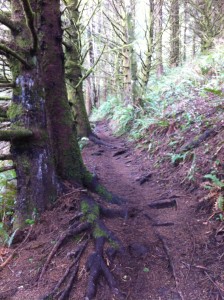 The trail starts just above the coast and switches back and forth as you climb up through the rainforest. The vegetation is a bit less dense than summer, but the moss and lichens are as thick as ever. And of course the occasional gigantic old growth fir tree that demands a hug. Tree Huggers were born here.
The trail starts just above the coast and switches back and forth as you climb up through the rainforest. The vegetation is a bit less dense than summer, but the moss and lichens are as thick as ever. And of course the occasional gigantic old growth fir tree that demands a hug. Tree Huggers were born here.
Neahkahnie is a Tillimook Indian word that means “place of the supreme deity,” possibly because of the summit views, 1600 feet above cliff faces dropping into the wild ocean and glimpses of the dense green forest through whisping fog.
There are also legends of Spanish treasure being buried on the mountain that date from the 1800s. If true, you can understand why it hasn’t been found. Hiking off the trail through thick underbrush looks impossible. Also, the mountain is currently part of an Oregon state park. Hopefully no more hunters try to dig pointless pits in this mountain, the real treasure is obvious from the summit.
After this hike I went down and walked along the beach outside the little town of Manzanita. It seemed to go for miles and the waves were mesmerizing, constantly approaching and breaking in different ways each time.
No trip is finished until you sample the local pub. This time it was the Sand Dune Pub. The variety and availability of local craft beer in Colorado is only outdone by Oregon. But since I am a beer drinking barbarian, I of course opted for an unmentionable brand light beer.
Cheers!
Posted in Trip Reports by Mark with comments disabled.
The Real World

Lisa Foster from the Estes Park News
I’ve always said:
“If you look at the victims of accidents in the mountains, they are evenly distributed between the novices and the experts. Neither the beginner nor the expert veteran are excluded from this law of nature.”
Well ok, maybe I haven’t always said that, and perhaps I’m paraphrasing, but this was the most important theme of Colorado 14er Disasters. Lisa Foster, pictured above, is most certainly one of the experts. She and David Laurienti were caught in an avalanche on Mount Ypsilon in Rocky Mountain National Park last weekend. Laurienti was killed while Foster survived but was injured and rescued.
Ypsilon is a popular climb in both summer and winter because it is relatively easy to access and has many routes ranging from easy hikes to technical rock to snow couliors (steep snow routes). Lisa Foster had extensive climbing experience all over Colorado and had climbed both Aconcagua and Denali. She had written one of the most popular hiking guides for Rocky Mountain National Park.
Yet she and Laurienti were caught in an avalanche, something that seems to be completely avoidable, especially by an expert mountaineer. Or was it? Reading this story while sitting comfortably at home with an unstressed (and inexperienced) mind, being lead along by a story that emphasizes, in hindsight, the stupid mistakes made, it could be easy to judge these people to be reckless or at least careless about climbing. But think again. No one, especially a mountaineer so viscerally in love with living, is intentionally so cavalier with their life.
Mountaineers are human of course and they do make mistakes. And just like everyone else, when distracted by exhaustion, thirst, hunger, cold, and the little aches and pains of high altitude winter climbing, mistakes can come more easily. I don’t know what happened on Ypsilon last weekend, but this happens to both the novice and expert.
Foster is most certainly a mountaineering expert. The media uses this word, usually without justification, to dramatize accidents. In Foster’s case there is vast evidence to prove it, a declaration from an ignorant reporter is superfluous. And so these things happen. So next time you hear about a mountaineering accident, remember that we are all human and accidents are part life. The only thing we choose is how we live.
Posted in Journal by Mark with comments disabled.
St. Vincent and the Grenadines, Part 3
 Shelly On The Beach, Chatham Bay
Shelly On The Beach, Chatham Bay
After all the excitement of the first half of the trip, things settled down a bit. We had become familiar enough with the, ah, nuances, of the La Paloma to be comfortable in most of the sailing situations we would encounter.
 One of the cool things we saw at almost every island were these big, multi-mast sailing ships. Everything from three to five masts, some of them were cruise ships that had accommodations for maybe up to 100 people or more. The really big ships would anchor way out at the entrance of the bays and most of them would have their masts lit up at night. Also, I guess Pirates of the Caribbean was filmed on St. Vincent and one of the Gaff rigged ships used in the movie was anchored at Tobago Cays.
One of the cool things we saw at almost every island were these big, multi-mast sailing ships. Everything from three to five masts, some of them were cruise ships that had accommodations for maybe up to 100 people or more. The really big ships would anchor way out at the entrance of the bays and most of them would have their masts lit up at night. Also, I guess Pirates of the Caribbean was filmed on St. Vincent and one of the Gaff rigged ships used in the movie was anchored at Tobago Cays.
We also met some interesting people over the course of the trip. One family from New York had chartered a mono-hull and  went through the briefing the same day we did. They anchored near us in the Cays (actually too close to us) and invited us for happy hour one night. We also met a group of Canadians, eh! They were in the cat on the right. We met them at a lobster barbecue at Chatham Bay. They were having a good ‘ol time and invited us to sit with them for dinner. After dinner we were “treated” to live music that consisted of one guy singing reggae songs while strumming a painfully out-of-tune guitar. The next day we both sailed to Saline Bay on Mayreau Island where we were invited to their cat for happy hour. It was amazingly large and modern compared to our boat and cost about twice what we were paying. We prefer mono-hulls though, they can sail more directly into the wind.
went through the briefing the same day we did. They anchored near us in the Cays (actually too close to us) and invited us for happy hour one night. We also met a group of Canadians, eh! They were in the cat on the right. We met them at a lobster barbecue at Chatham Bay. They were having a good ‘ol time and invited us to sit with them for dinner. After dinner we were “treated” to live music that consisted of one guy singing reggae songs while strumming a painfully out-of-tune guitar. The next day we both sailed to Saline Bay on Mayreau Island where we were invited to their cat for happy hour. It was amazingly large and modern compared to our boat and cost about twice what we were paying. We prefer mono-hulls though, they can sail more directly into the wind.
 The most interesting couple had been living on their small, 34-foot sailboat for 7 years. In that time they had circumnavigated the world, among other things. Their boat was called the Coromandel. They were British and so between them had a bunch of experience prior to living on their boat, but they told us that sailing around the world is quite easy. You follow the trade winds that continuously blow in the same direction all around the globe.
The most interesting couple had been living on their small, 34-foot sailboat for 7 years. In that time they had circumnavigated the world, among other things. Their boat was called the Coromandel. They were British and so between them had a bunch of experience prior to living on their boat, but they told us that sailing around the world is quite easy. You follow the trade winds that continuously blow in the same direction all around the globe.
The last two days of sailing were tough. We sailed from Mayreau to Bequia, about 25 miles upwind, in one day. It was about 7 hours of having the boat heeled to one side while riding bumpy waves. The following day was only about two hours back to St. Vincent but the seas were of course a bit rougher in the Bequia Channel.
All-in-all a great trip. Our goal was to sail somewhere a bit more challenging than in the past an we got what we asked for. As a matter of fact, I think we’re going to have a difficult time tolerating winds less than 20 mph, they’ll seem much to wimpy!
Posted in Sailing by Mark with comments disabled.
St. Vincent and the Grenadines, Part 2
An Approaching Storm off the Port Bow
It turns out that day 1 was the most exciting single day of the trip, though the adventure was far from over. The next day we started out intending to make the long passage to Canuoan Island but as we started motoring out of the bay the engine started banging as it had the day before. We made the decision to call for a repair rather than risk losing the engine completely. This gave us a day to hang out and relax and it wasn’t really a problem as Shelly had built in some spare days into our schedule.
We hung out and did some snorkeling and waited for a local boat repair guy to show up. At some point in early afternoon a long, flat and beat-up old workboat approached with tall, gray-haired guy and a pint-sized mutt laying on the bottom. It was Robin, an old English guy who looked like he had slept on the beach for the last 20 years. He barely said hello and got straight down to the engine. He thought the engine mountings were loose and had to return later with the tools to tighten them up. No problem, we were around for the day anyway. He did his work later that evening and we spent our second night in Admiralty Bay.
 Got going early the next morning without incident. It was cloudy but the wind was steady. We motored out around the west point of Bequia where we saw this shipwreck on the left. It looked like a commercial boat had tried to cut between two cays, little islands off the west point where the water is quite shallow. The rust on the boat indicated the wreck had been there a while.
Got going early the next morning without incident. It was cloudy but the wind was steady. We motored out around the west point of Bequia where we saw this shipwreck on the left. It looked like a commercial boat had tried to cut between two cays, little islands off the west point where the water is quite shallow. The rust on the boat indicated the wreck had been there a while.
We navigated well clear of the point and headed south. This mean we pointed somewhat southeast as the current down here pushes you west and it’s fairly strong and steady. The wind was good and steady and the waves were only about 5 feet. Soon we were engulfed in a series of squalls. For those who haven’t experienced these, they basically look like approaching thunderstorms. On the ocean, however, these things come at you much faster than you think. They look relatively far away but then wham, they hit and throw you around if you are unprepared. The problem for a sailor is that, just as in a thunderstorm on land, the wind shifts wildly in speed and direction. It’s better to reef or take your sails in completely in these storms. These squalls only last a few minutes and dump a ton of rain on you, but then they’re gone.
The La Paloma was equipped with a radar and it turned out to be an excellent tool to determine when and where the storm would hit. We watched one approach us from behind, overtake us with rain and wind and then move off.
The passage to Canouan is about 20 miles and we sailed all the way. We anchored in Charleston bay and got some provisions in town.
 The next day we had a short sail to the Tobago Cays, a protected marine park consisting of several small islands surrounded by coral reefs. We anchored in this very popular preserve for a couple of days. The first thing we did was to reserve our place for a lobster barbecue dinner on the beach. A guy will come out to pick you up and bring you back to your boat after dinner. They do not catch the lobster in the park but bring it in from the surrounding area. Good stuff and the dinner was so large no one could possibly eat it all.
The next day we had a short sail to the Tobago Cays, a protected marine park consisting of several small islands surrounded by coral reefs. We anchored in this very popular preserve for a couple of days. The first thing we did was to reserve our place for a lobster barbecue dinner on the beach. A guy will come out to pick you up and bring you back to your boat after dinner. They do not catch the lobster in the park but bring it in from the surrounding area. Good stuff and the dinner was so large no one could possibly eat it all.
 The next day we motored our dinghy over to one of the little islands and hiked to the top for a great view (right). We then snorkeled around a bit just off shore. Here and over the whole trip we saw huge schools of psychedelic tropical fish, a three foot wide manta ray, lobster, turtles, sea snakes (!), sea urchins, fish that look like rocks, and lots of young, green coral. Every once in a while you would see this coral that is shaped like a planter, a little bowl that would have other things growing in it, very strange and beautiful. On shore we saw another strange site: the hindquarters of something trotting away that was about
The next day we motored our dinghy over to one of the little islands and hiked to the top for a great view (right). We then snorkeled around a bit just off shore. Here and over the whole trip we saw huge schools of psychedelic tropical fish, a three foot wide manta ray, lobster, turtles, sea snakes (!), sea urchins, fish that look like rocks, and lots of young, green coral. Every once in a while you would see this coral that is shaped like a planter, a little bowl that would have other things growing in it, very strange and beautiful. On shore we saw another strange site: the hindquarters of something trotting away that was about  the size of a cat but white with black rings. Shelly overheard a local tour guide say it was a white Iguana. A big one.
the size of a cat but white with black rings. Shelly overheard a local tour guide say it was a white Iguana. A big one.
Back at the La Paloma, I swam out to check our anchor (good) and investigate the sand bank that was about 100 yards off our starboard bow. I swam over to it and it and saw that it was a vast underwater sand plateau only about 4 feet deep. You could walk around on this thing that appeared to be in the middle of the ocean. A strange sight for a Colorado boy.
 As I mentioned earlier, the anchorage was fairly crowded, we were on one edge near the sand bank. The cats (catamarans) could anchor in much shallower water than we could so they could creep closer to the sand bank as you can see in the sunset pic on the left. We ended the day with dinner and drinks on board. Can’t eat that lobster every day. Well, maybe you could but even though it was half to 2/3rds the price of lobster here, it was still expensive.
As I mentioned earlier, the anchorage was fairly crowded, we were on one edge near the sand bank. The cats (catamarans) could anchor in much shallower water than we could so they could creep closer to the sand bank as you can see in the sunset pic on the left. We ended the day with dinner and drinks on board. Can’t eat that lobster every day. Well, maybe you could but even though it was half to 2/3rds the price of lobster here, it was still expensive.
 We watched another beautiful Carribean sunset out the back of our from the deck. Ok, let’s face it, every sunset was beautiful down there!
We watched another beautiful Carribean sunset out the back of our from the deck. Ok, let’s face it, every sunset was beautiful down there!
We left late the next morning on our way to Chatham Bay on Union Island. This would be a moderate sail, swinging around the north side of Mayreau Island and down around the south side of Union Island. This seemed to be a roundabout way to get to our destination but it was actually the shortest route possible. What appeared to be a direct route was blocked by underwater barrier reefs that we needed to avoid. On the way out we said goodbye to a little spit of sand off one of the islands (left) where dozens of sea turtles would swim with you as you snorkeled.
On the way out we said goodbye to a little spit of sand off one of the islands (left) where dozens of sea turtles would swim with you as you snorkeled.
Our water tanks were running low so we decided to stop at Clifton Harbor on Union Island to refill. It was on the way to Chatham Bay, which has no services. You come into a dock where they run a hose out to you and fill up on water, we needed about 60 gallons at this point. Seemed easy enough. Shelly maneuvered perfectly into the dock and we tied on, they ran a hose out and we filled up. In the meantime some guys said they would run into town and buy us a few groceries and get some ice. Though you have a fridge on the boat it can only be turned on while the engine is running, and that isn’t very often. You need ice to help keep it cold the rest of the time.
We finished up with the water and were just waiting for the guys to return with our groceries when a boat came in wanting water. The dock was small so they asked to raft to our boat. That means they would tie to the outside of our boat instead of the dock, a common technique when there isn’t much space. We said OK.
Well they came in way too fast, like a scud missle. We told them to veer off and try again. They almost collided with us at relatively high speed. Um, ok, so change of plans. We’ll be nice and leave the dock and anchor to wait for our groceries which should be by soon. We left the dock and dropped an anchor. Bad idea. Because this is an old harbor, there apparently is a bunch of old junk on the bottom. So we found that our anchor got hooked on something and we were stuck. The guidebook shows this area as a valid anchorage, but trust me, it is not.
Anyway, we ended up paying a guy an exorbitant amount to dive down and unhook our anchor. It was stuck probably 30 feet down. In the meantime our groceries showed up. We finally got away, in fact ran away from that harbor, with two expensive sailing courses: Where Not To Anchor 101, and How To Unhook Your Anchor 101. But the day wasn’t over yet…
We got out and put up sails in a good, stiff wind. At some point we did a controlled jibe. Though not taught to beginners, is a perfectly valid maneuver as long as you control the boom of the mainsail. We did that OK but the jib (front sail) got pushed around the front of fore stay and wrapped a couple of times. This is not good. Our sail looked something like below. For non-sailors, trust me, it is not supposed to look like this:

At the time we could not unwrap it because it was too windy, so we motored closer to the island to figure it out. And we did get it fixed fairly quickly. Another course passed, How To Untangle A Jib Sail 101.
We finally made it to Chatham Bay, a very peaceful and beautiful anchorage, below.
The last part of the story to come next in part 3.
Posted in Sailing by Mark with comments disabled.
Sailing St. Vincent and the Grenadines, Part 1
The La Paloma
Ok, I haven’t posted for a while but I’m finally catching up with this first part of our sailing trip around St. Vincent and the Grenadines. Shelly and I did a bareboat charter (just the two of us) and had some challenging sailing in the southern Caribbean.
We flew out of Denver just as one of the larger snowstorms of the year was developing. Landed in Grenada and stayed overnight. You remember Grenada, the little country that Reagan had the military invade in 1983. This small island must have been completely overwhelmed by that action and the point was made, like pushing in a thumb tack with a sledge hammer. Anyway, it was a beautiful place, what little we saw before island hopping to St. Vincent the next morning.
We had the next entire day to hang out in St. Vincent . We stayed at the Beachcombers Hotel right on the beach. Nice place with an outdoor bar where you could grab a beer and watch the sailboats cruise in what appeared to be a calm sea just offshore, which I am doing in the pic on the right. The local St. Vincent beer is called Hairoun, which happens to be the native Carib name for St. Vincent. It means “land of the blessed.” That might well be a true saying, but unfortunately they haven’t been blessed enough to bottle their beer in 12-ounce size. Each Hairoun was in an 8-ounce bottle. You have to order Presidente beer to get your 12-ounce size. And the price is about the same. Go figure. And truth be told, Presidente is better beer (disclaimer: Do not, under any circumstances, take my recommendations as to what makes a good beer. If you do, you will likely be severely disappointed and develop deep anger and resentment).
. We stayed at the Beachcombers Hotel right on the beach. Nice place with an outdoor bar where you could grab a beer and watch the sailboats cruise in what appeared to be a calm sea just offshore, which I am doing in the pic on the right. The local St. Vincent beer is called Hairoun, which happens to be the native Carib name for St. Vincent. It means “land of the blessed.” That might well be a true saying, but unfortunately they haven’t been blessed enough to bottle their beer in 12-ounce size. Each Hairoun was in an 8-ounce bottle. You have to order Presidente beer to get your 12-ounce size. And the price is about the same. Go figure. And truth be told, Presidente is better beer (disclaimer: Do not, under any circumstances, take my recommendations as to what makes a good beer. If you do, you will likely be severely disappointed and develop deep anger and resentment).
The next day proved to be an adventure. We showed up at the charter office around 9 am but the boat wasn’t ready. The jib sail (the one in front) was being repaired and the engine was having issues. They replaced the coolant pump. By the time we could get sailing it was almost 3 pm, pretty late. We needed to get to Bequia, the nearest island, which could take more than a couple of hours.
We discovered that our boat, the La Paloma, had a main sail that furled in and out of the mast. The usual rigging for the main sail on a mono-hull boat is to raise and lower the sail using a rope called a halyard, so when you want to sail you raise the mainsail and when you want to stop sailing you drop the main down to the boom. If you look at the diagram below, our sail rolled left and right into and out of the mast, while most mono-hulls have the main sail go up and down from the boom. This was new to us but it seemed way more convenient.

NOT! The last thing the charter guys said to us as we were leaving was that “sometimes the sail sticks” and you have to go up on deck to pull the sail out of the mast. What he meant was that it always gets stuck and you have to go out and heave mightily on the damn thing every time you unfurl it. We didn’t think much of it at the time, but it turned into a major difficulty. And keep in mind they had just made a last minute repair of the engine…
SO… We depart and get into some good wind and want the sails up. We try cranking the mainsail out of the mast and it jams up quite nicely. Yes, we did have to go out on deck and pull the thing out by hand. In the meantime the boat is rocking on the waves and the big sail is flapping, you had to be extra careful not to get pitched overboard. But we did get it out after much struggle and quite vocal raging. The waves are fairly high in the channel, as much as ten feet, and it’s generally choppy as we ride up and down. We also discover the wind is a bit higher than we are used to, it was pretty steadily 20+knots (22 mph) so we were moving fast as well.
It turned out that the conditions in the Bequia Channel were the most challenging of the trip, which is all fine and dandy except that this was our first hour of sailing and we were still getting the feel for the boat. As we approached the island of Bequia, the waves got a bit higher and the wind became gusty and variable in direction, making it extremely difficult. This is an effect of the channel and the island. Winds break up and gust around the island while in the same vicinity the ocean floor is rising from a thousand meter depth to a few hundred feet, causing the water to be choppy and wavy.
The sails are set based on the wind direction and when it starts the shift around faster than you can adjust the sails, the boat becomes more unstable. In those situations you generally reef the sails, meaning you make them smaller so the wind can’t push you as hard, or you take them in entirely. We reefed both the main and the jib but conditions got worse, waves were breaking over the railing and the boat became very difficult to control. This isn’t normally a big problem, the solution is to take in the sails completely, which stabilizes the boat, and motor in (all these sailboats have a motor as well as sails to get around). The trick is to get the sails down in the high wind while your boat is pitching around. You do this by turning on the diesel engine, engaging it and pointing the boat into the wind to take the force off the sails so you can take them down.
Well, the engine started just fine but when I engaged the propeller forward it began a periodic BANG… BANG… BANG that shook the entire boat and did not engage the propeller. This was the first time we had used the motor. Not good. Not good at all. I played around with the engagement lever for a minute and it started to work. I then pointed the boat into the wind and Shelly was able to get the sails in while big waves broke over the bow, soaking us with ocean water. I started to get seasick…
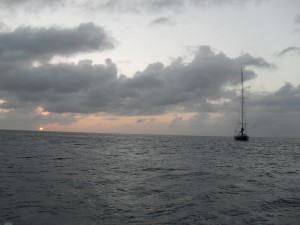 As soon as we rounded the point on Bequia it was calm and things got much better. We motored into Admiralty Bay and set our anchor. Because we got there relatively late, around 5 pm, the anchorage was rather full and we had to pick a spot that was a bit deeper and more windy than was ideal, but it seemed good enough. Anchoring conditions are actually very good on all these islands. We finally got a chance to relax, have a drink and fix dinner on board. We watched the sun set over the Caribbean sea, left. Note that there were many more boats around us than are shown in this pic but this was a nice view.
As soon as we rounded the point on Bequia it was calm and things got much better. We motored into Admiralty Bay and set our anchor. Because we got there relatively late, around 5 pm, the anchorage was rather full and we had to pick a spot that was a bit deeper and more windy than was ideal, but it seemed good enough. Anchoring conditions are actually very good on all these islands. We finally got a chance to relax, have a drink and fix dinner on board. We watched the sun set over the Caribbean sea, left. Note that there were many more boats around us than are shown in this pic but this was a nice view.
After dinner we remained on deck as it rapidly got dark. There is essentially no twilight near the equator. As soon as the sun drops below the horizon you’ve got about 15 minutes before it is completely dark. While sitting there I noticed we appeared to be much closer to the boat behind us than we were when we anchored. We watched it for a while and yes, we were definitely much closer. Our anchor was dragging, placing us dangerously close to another boat.
What was pushing us? The boat is affected by both wind and current. I suspect the major contributor was wind pushing us as we were in a stiff, steady breeze. Unfortunately we did not start dragging until it was completely dark. We were not dragging earlier as we always follow the standard procedure to watch our position for a while after anchoring to check.
We were not in a good situation because to fix this we had to reset the anchor and this involves maneuvering the boat, raising the anchor and dropping it somewhere else. There were boats anchored very close by, like within 100 feet, and moving around in the dark is dangerous. Boats are generally not lit well at night and there are anchor lines you can hit. But we had no choice and fortunately, we were able to raise the anchor, maneuver and reset without hitting anything. We sat on deck checking the line for about 45 minutes to make sure it was OK. It was. Throughout the night we would get up and check out position but there were no further problems.
THAT was day one. This is adventure!
More to come…
A long week
Well this has been a long work week and I wasn’t motivated enough to post anything earlier, but now it’s Friday!
Last weekend we were in town and planned on going Nordic skiing at Eldora on Sunday. But after breakfast it was just too spring-like in town to even consider going up to the cold snow and so we did a short hike on some trails just south of Eldorado Springs. It was a good choice, very low-key and uncrowded. This is in contrast with popular areas like Chatauqua or Mount Sanitas, where it would have been difficult to find a parking space on Sunday within a half mile of the traiheads. It was a beautiful day.
I had the day off on Monday and did end up going to Eldora to skate ski. The weather was terrible! It was about 15 degrees with high wind. Track conditions were better than last month but not by much. The tracks were icy and thin. I was able to get in a good hour of skating, though.
Here is another article about charging search and rescue victims to recover some of the costs for the operations. It is highly unlikely this will ever happen in Colorado due to the volunteer nature of rescue groups. This kind of story is reported in the media every so often anyway, probably because it generates strong feelings, mainly indignation from those who aren’t fully aware of all the issues. I’ll write some more about this subject in the future. There is a quote from a friend from RMR, Dan Lack (who is incorrectly identified as belonging to “Rocky Mountain Rescue Association,” a non-existent entity). Dan, by the way, is the crazy Australian who suggested the title Playing for Real for my book in 2006.
We finally got a significant snowfall in Boulder from an upslope storm this week. It dumped about 5 inches in town near the foothills. Kind of feels like winter again!
Posted in Journal by Mark with 1 comment.

